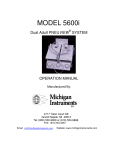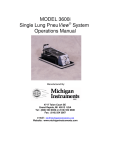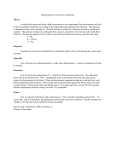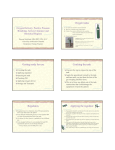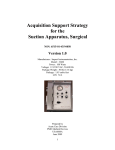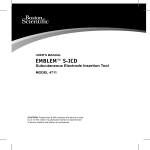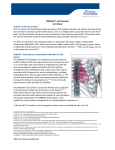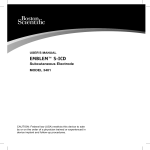Download Training & Test Lung Operation Manual
Transcript
Training & Test Lung Operation Manual 4717 Talon Court SE Grand Rapids, MI 49512 USA (800) 530-9939 or (616) 554-9696 Fax: (616) 554-3067 [email protected] www.michiganinstruments.com REV: 2014-11 Page 1 of 22 Contents Introduction............................................................................................................................................ 4 Cautions .............................................................................................................................................. 4 Description ............................................................................................................................................. 5 The TTL in Action ................................................................................................................................ 5 The TTL As Compared to Typical Patients .......................................................................................... 5 The TTL As Compared to Ventilator Testing Standards ...................................................................... 6 Components and Features ..................................................................................................................... 7 The Airway .......................................................................................................................................... 7 The Volume Scale ............................................................................................................................... 7 The Compliance Scale ......................................................................................................................... 7 Pressure Gauges ................................................................................................................................. 7 Oxygen Sensor Ports........................................................................................................................... 7 Auxiliary Pressure Ports ...................................................................................................................... 7 PneuFlo® Resistors ............................................................................................................................. 8 Pressure Pickoff Adaptors .................................................................................................................. 8 The Lungs (Bellows) ............................................................................................................................ 8 Lung Coupling Clip (Dual Adult Only) ................................................................................................. 8 Y-Adaptor (Dual Adult Only) ............................................................................................................... 8 Miniature Quick Connectors .............................................................................................................. 8 Setup and Operation .............................................................................................................................. 9 To Begin .............................................................................................................................................. 9 Single-Lung and Infant-Lung Setup..................................................................................................... 9 Dual-Lung Setup ................................................................................................................................. 9 To Set Lung Compliance ..................................................................................................................... 9 To Measure Oxygen Concentration.................................................................................................... 9 Spontaneous Breath Simulation ....................................................................................................... 10 Care for the TTL After Ventilation With Humidified Gasses ............................................................. 10 Applications .......................................................................................................................................... 11 Equipment Testing............................................................................................................................ 11 Classroom Instruction....................................................................................................................... 12 Other Common Applications ............................................................................................................ 12 REV: 2014-11 Page 2 of 22 Maintenance and Service ..................................................................................................................... 14 Limits of Tolerance and Accuracy ..................................................................................................... 14 Calibration ........................................................................................................................................ 14 Checking Calibration: Adult Lung ..................................................................................................... 15 Checking Calibration: Infant Lung .................................................................................................... 15 TTL Leak Test .................................................................................................................................... 16 Warranty Agreement........................................................................................................................ 16 Factory Service Policy ....................................................................................................................... 17 What to do if Your TTL Requires Service .......................................................................................... 17 Storage and Shipping ........................................................................................................................ 18 Securing the TTL for Transport ......................................................................................................... 18 Shipping the TTL with the carrying/storage case ............................................................................. 18 Shipping the TTL without the carrying/storage case........................................................................ 18 Shipping the TTL without using the original shipping carton ........................................................... 19 Pathophysiology Simulation Settings ................................................................................................... 20 “Normal” or healthy lung characteristics ......................................................................................... 20 Diseases affecting the airways, like Chronic Obstructive Pulmonary Disease (COPD) .................... 20 Diseases affecting Lung Compliance, like Emphysema .................................................................... 21 Acute Asthma Attack ........................................................................................................................ 21 Collapsed Lung.................................................................................................................................. 21 Pneumothorax / Hemothorax .......................................................................................................... 22 REV: 2014-11 Page 3 of 22 Introduction The Michigan Instruments’ Training and Test Lung (TTL) is a dynamic lung simulator commonly used to evaluate and demonstrate mechanical ventilation and phenomena. Simulation of pulmonary pathologies and the evaluation of ventilators are also among the many uses of the device. This manual is intended to fully describe the mechanical function of these units and provide the information necessary to utilize and maintain the instrument. This is not a repair manual and does not contain the documentation and directions required to fully service a TTL. Please contact Michigan Instruments directly if service or assistance is required. The Michigan Instruments’ Service Department can be reached at (800) 530-9939 x343. Cautions • • • • CAUTION Operate all TTL units within their specified limits. Over-inflation of the bellows or excessive pressure within the system may cause damage to the bellows and gauges. CAUTION Damage can be done to a TTL during shipping if the unit is improperly packaged. Refer to Section 5 for proper shipping instructions. CAUTION Do not sterilize the TTL. Some internal components are not compatible with sterilization techniques. CAUTION Do not adjust the compliance setting during use. Changing the compliance setting while ventilating the lung may cause damage to the unit. REV: 2014-11 Page 4 of 22 Description The TTL is a unique, versatile instrument that provides simulation of the structures and mechanics of the human pulmonary system. Through the use of elastomer lung compartments it accurately reflects typical adult and infant residual lung capacity. A simple but comprehensive set of controls provides the user with the ability to adjust the airway resistance and lung compliance of the TTL with ease. These adjustments allow for the simulation of both healthy and diseased lungs. The TTL in Action When in use, the TTL allows for accurate simulation of the pulmonary system. Gas is inserted into the bellows of the TTL through a simulated airway by means of a ventilator, resuscitation bag, etc. This causes the vertical expansion of the lungs, and a corresponding rise of the top plate. Gauges on the front of the unit provide measurement of intra-lung pressures in the system as well as the airway pressure. The TTL can be further adjusted by means of the compliance spring(s) located on the side(s) of the device. The compliance springs are easily set by means of the compliance scale marked on the device. The TTL has been designed to ensure that the compliance values marked on the device are accurate. The resistance of the simulated pulmonary system is adjusted by means of a fixed-orifice flow restrictor. These are interchangeable in the simulated airway. These features of adjustable compliance and resistance allow the TTL to accurately represent the function of both healthy and diseased lungs in ventilation procedures and simulations. The device can also be used to simulate a spontaneously breathing patient. The Oxygen sensor port on the top of each lung compartment and auxiliary pressure port adjacent to the pressure gauge provide for the tie-in of related monitoring equipment. The TTL As Compared to Typical Patients The TTL is designed to realistically simulate the mechanics of the pulmonary system from the upper airway through the lungs. It offers simulation capabilities and versatility and is useful for a wide variety of applications. Variable lung compliance and airway resistance allow for simulation of both healthy and diseased pulmonary conditions. Pulmonary disease is often associated with a change in lung compliance and/or airway resistance. The table below offers some typical values for healthy adult lungs. Refer to Pathophysiology Simulation Settings for a description of how the TTL can be used to replicate the characteristics of a diseased lung. REV: 2014-11 Page 5 of 22 Compliance 0.05 to 0.10 L/cmH2O Resistance 0.5 to 5.0 cmH2O/L/sec Respiratory Rate 10 to 20 bpm Tidal Volume 3 to 5 mL/kg of body weight I:E Ratio 1 to 2 The TTL As Compared to Ventilator Testing Standards To evaluate the performance of any mechanical ventilation device, a quantitative test lung which dynamically simulates human physiology should be utilized. Testing should take place on every ventilator before it is used in the clinical setting, and periodic testing is needed to ensure that the unit is performing in accordance with established standards as well as the manufacturer’s specifications. The TTL is an ideal device for any such evaluation. Standards published by the American National Standards Institute (ANSI), the International Organization of Standardization (ISO), and the American Society for Testing and Materials (ASTM) outline minimum performance standards for such ventilators. The TTL meets or exceeds the requirements set for testing in these standards. Standards References: ANSI Z79.7, ISO 80601-2-12, ISO 80601-2-13, ASTM F 1100-90 REV: 2014-11 Page 6 of 22 Components and Features The Airway Ventilators attached to the TTL for either testing or training purposes insert air into the lung through the airway. The airway is constructed by using a hose assembly, various connectors, and a set of the PneuFlo® Airway Resistors included in your accessory kit (refer to section 2 for a description of how to properly assemble the airway). Tapered fittings on all of these accessories prevent gas leaks during use. Airway resistance in the TTL exhibits parabolic characteristics in regards to pressure change as a function of flow. This nonlinear, parabolic characteristic is similar to that seen in standard endotracheal tubes. The airway may be attached to either one or both (in the case of a dual lung) of the lungs of the TTL depending on the ventilation scenario. An airway is used in both dual lung and single lung simulations. The Volume Scale The volume scale allows the user to easily observe the approximate tidal volume of each simulated lung while the unit is in use. To ensure an accurate measurement, the sliding volume indicators underneath each scale should be set according to the selected compliance prior to reading. When the unit is in use, the volume scale should be in its upright and locked position. When not in use it should be flipped down to prevent damage to the unit. The Compliance Scale The compliance of each lung can be independently adjusted by means of the compliance spring. The scales by which the compliance level is set are calibrated prior to shipping the device. To ensure that compliance is set accurately, position the compliance spring perpendicular to the top plate during use. Pressure Gauges The front plate of the TTL contain pressure gauges that will display both proximal and intra lung pressure during use. These gauges are labeled according to the parameters that they represent. Oxygen Sensor Ports An oxygen sensor port located on the top of each lung allows for the analysis of oxygen content during ventilation. These ports may also be used to drain the device of fluids after ventilation with humidified gasses. Auxiliary Pressure Ports Auxiliary pressure ports located next to each of the pressure gauges allow for monitoring pressure with third party devices. These ports are equipped with a check valve and will remain closed unless they are fitted with a miniature quick connector (included in the accessory kit). REV: 2014-11 Page 7 of 22 PneuFlo® Resistors Included with the TTL are several PneuFlo resistors that allow the user to simulate different airway resistances during operation. These can be used to specify upper airway resistance in both single lung and dual lung simulations and lower airway resistance in dual lung simulations. Pressure Pickoff Adaptors Pressure pickoff adaptors (double port and single port) are included with the TTL. These can be placed at strategic locations in the airway during setup to allow for the monitoring of pressure (by means of the proximal pressure gauge or a similar device). The Lungs (Bellows) The TTL simulates the human pulmonary system through the use of elastomer bellows, constrained by aluminum rings to ensure that filling of the lung(s) results in a vertical rise of the top plate(s). The bellows retains a gas volume typical of a functional residual capacity for a single lung at rest. The bellows are designed to withstand normal environmental conditions and inflation to at least 120 cmH2O. Lung Coupling Clip (Dual Adult Only) The lung coupling clip is used only in spontaneous breathing lung simulation. Attaching it to the TTL allows one simulated lung chamber to act as a driving chamber for the other lung during testing. Y-Adaptor (Dual Adult Only) This adaptor is used to split the airway during dual lung simulation. It is not used during single lung simulation. Miniature Quick Connectors Miniature quick connectors are included. These may be attached to the auxiliary pressure ports of the TTL during ventilation to open the check valve and allow for additional ventilation analysis. REV: 2014-11 Page 8 of 22 Setup and Operation To Begin 1. Place the TTL on a level working surface. 2. Raise the volume scale plate(s) to the upright and locked position. 3. All parts needed to construct the airway are located within the TTL accessory case. Single-Lung and Infant-Lung Setup 1. Select one Pneuflo resistor to simulate total airway resistance and connect it to the 15mm airway adaptor. 2. Connect the other end of the 15mm airway adaptor to the lung inlet port. 3. Attach a single-outlet pressure pickoff adaptor to the proximal end of the Pneuflo resistor, and using the 1/8” hose, connect this adaptor to the proximal pressure input port. Dual-Lung Setup 1. Select one Pneuflo resistor to simulate upper airway resistance and two resistors to simulate lower airway resistance according to the test that you wish to perform. 2. Connect the selected upper airway resistor to the Y-adaptor. 3. Connect one end of each hose assembly to the Y-adaptor and the other ends to the selected lower airway resistors. 4. Attach a single-outlet pressure pickoff adaptor to the proximal end of the upper airway resistor, and using the 1/8” hose, connect this adaptor to the proximal pressure input port. 5. Attach a 15mm airway adaptor to each lung inlet port. 6. Connect the free end of the lower airway resistors to the 15mm airway adaptors. To Set Lung Compliance 1. Loosen the knob on the compliance spring. 2. Grasp the compliance spring and slide the entire mechanism until the pointer is positioned on the desired setting. 3. Ensure that the spring hangs perpendicular to the lung top plate. 4. Lock in place by tightening the knob. To Measure Oxygen Concentration 1. Remove the oxygen port cover. 2. Place an appropriate oxygen sensor into the port. 3. Connect the oxygen sensor to the desired test instrument. (In the case of a PneuView equipped unit, the O2 jack on the back plate can be used). REV: 2014-11 Page 9 of 22 Spontaneous Breath Simulation A Dual Adult TTL can be set up for spontaneous breath simulation. See the following instructions for the appropriate assembly of spontaneous breath simulation. 1. Set up the TTL for single-lung ventilation (described above). The right lung will serve as the spontaneously breathing lung. 2. Set an appropriate compliance (right lung) and resistance (right lung) for the conditions to be simulated. 3. Attach the Lung Coupling Clip to the top plate of the left lung in the provided position (shown below). This lung will be the “driving chamber” which will serve as the musculature of the spontaneously breathing lung. 4. Attach a hose assembly to the inlet port of the driving chamber. Set the compliance spring of the driving chamber to 0.03. 5. Ventilate the driving chamber with the appropriate rate, volume, waveform, etc. for spontaneous breathing. As the driving chamber fills, the Lung Coupling Clip will lift the top plate of the spontaneous breathing lung. This will create a negative pressure in that lung during inspiration and allow passive exhalation, as seen in normal spontaneous breathing. NOTE: A resistor is not normally used in the airway of the driving chamber as the altered flow rate produced can interfere with the natural rise and fall of the top plate of the spontaneous breathing lung. NOTE: It is recommended that a Michigan Instruments Breath Simulation Module (BSM) be used during spontaneous breath simulation. Additional information on the BSM as well as brochures and product quotes are available online at http://www.michiganinstruments.com/breath-simulation. If a BSM is used, refer to the BSM manual for specific setup instructions for the device. NOTE: The spontaneous breathing TTL setup is used in several applications including the evaluation of spontaneous breathing ventilator modes and work of breathing studies. Care for the TTL After Ventilation With Humidified Gasses The airway and lung(s) of the TTL are constructed of noncorrosive materials. Typical humidification agents such as sterile water and normal saline solution will not damage the instrument. Excess moisture should be drained after use. Any accumulated fluid can be drained through the oxygen sensor port located on the top plate by carefully inverting the unit with the sensor port caps removed. After the fluids are drained, replace the sensor port caps and ventilate the TTL with dry gas until no condensation remains. For more information on the use of the TTL with specific chemical agents and medications, contact us. REV: 2014-11 Page 10 of 22 Applications The TTL is an ideal instrument for a variety of applications including: • • • • • Performance Testing of Ventilators and Associated Instruments Classroom Instruction on Mechanical Ventilation Equipment, Techniques, and Phenomena Pulmonary Research Product Demonstrations and Evaluations Product Development and Quality Control It is beyond the scope of this manual to offer examples of all of the applications for this system, as new ones are continually being discovered and developed by TTL users. The following are a few of the most common tests for which the TTL is ideally suited. While these simple evaluations are by no means the only useful functions that the TTL provides, they are the basis on which the instrument was designed and provide an excellent starting point for any user. Equipment Testing The joint commission on Accreditation of Healthcare Organizations (JCAHO) states that “All equipment shall be calibrated and operated according to the manufacturer's specifications, and shall be periodically inspected and maintained according to an established schedule as part of the hospital's preventive maintenance program.” The TTL is designed to allow performance testing of ventilators intended for use on adult human patients. Use Case: Following a routine test protocol to create a table for documentation of test results. Procedure: 1. Set up the TTL for single lung ventilation. 2. Attach the patient connection of the ventilator's breathing circuit to the proximal airway of the TTL. 3. Set the ventilator in accordance with your test protocol. 4. Record the observed pressure, volume, FIO2, timing and flow measurements. 5. Repeat steps 1-4 for as many tests as necessary. 6. Record the results of each test, comparing the ventilator settings to the measured values. REV: 2014-11 Page 11 of 22 Classroom Instruction The TTL can be of great assistance in the classroom. The adjustable lung compliance and airway resistance allows the instructor or student to demonstrate or investigate a wide variety of ventilation phenomena. The relationships between pressure, volume, and flow are more easily understood when displayed using the TTL. There are few things more valuable in an academic environment than hands-on and visual experience. The TTL offers a look into the inner workings of the human pulmonary system that students would not otherwise have. Use Case: Pulmonary Simulation Procedure: 1. 2. 3. 4. Set up the TTL for ventilation. Set lung compliance to 0.05 L/cm H2O. Set total airway resistance to Rp5. Using a ventilator or resuscitation bag, ventilate the TTL at a rate of 12 bpm and tidal volume of approximately 0.800 L. 5. Note the tidal volume delivered to each lung. 6. Change the compliance of the right lung to 0.03, then 0.02, and finally 0.01, and note the differing lung volumes with each change. Use Case: Demonstration of Ventilation Phenomena (Requires a Dual Adult Lung) Procedure: 1. Set up the TTL for a dual lung ventilation. 2. Place Rp5 resistors in the right and left lower airways and an Rp20 resistor at the proximal airway (comparable to the resistance of a #6.0 endotracheal tube). 3. Set the compliance at 0.04 L/cmH20 in both the right and left lung. 4. Ventilate the TTL at a rate of 26 bpm and a tidal volume of 1.0 L with a baseline (PEEP) of zero. 5. Note the inadvertent PEEP in both proximal airway and right lung pressures caused by the increased airway resistance. Also note the difference in the baseline pressure of the proximal airway and right lung. Other Common Applications • • • • • • Performing in-hospital ventilator training sessions Troubleshooting ventilator malfunctions Checking ventilator systems for leaks Performing routine ventilator performance testing Testing the fail safe features of a mechanical ventilator Demonstrating the changes in functional residual capacity caused by PEEP and CPAP REV: 2014-11 Page 12 of 22 • • • • • • • Demonstrating the difference in cycling and limiting mechanisms in mechanical ventilators Demonstrating the difference between airway pressure and intra-lung pressures Evaluating new mechanical ventilators and ventilation monitoring equipment Identifying optimal ventilator settings for particular patients and conditions Performing work of breathing studies Evaluating the performance of high and low flow oxygen delivery systems And many more REV: 2014-11 Page 13 of 22 Maintenance and Service TTLs are designed to provide years of trouble-free service. Every unit is calibrated and thoroughly checked before leaving the factory. The compliance springs operate within only a small fraction of their potential range and exhibit no significant change in their performance characteristics after years of use. Likewise, the Pneuflo resistors and all accessories are designed for consistent, repeatable, long-term performance. With the exception of the replacement of lost parts and accessories, the unit is not intended to be serviced by the customer. If problems develop which cannot be easily corrected please contact the Michigan Instruments’ Service Department at (800) 530-9939 x343. Michigan Instruments recommends that all units be returned to the factory every two years for recalibration and any necessary upgrades. Limits of Tolerance and Accuracy Manufacturing and cost considerations mandate the use of practical tolerances on parts and components of any product, including the TTL. Major factors affecting final accuracy are compliance spring stiffness, bellows area and stiffness, scale calibration accuracy, resistor variations in inside diameter and interior wall geometry and smoothness. In the TTL, it is believed by both Michigan Instruments and its' customers that a practical balance has been achieved between cost and performance, and that the standard accuracy tolerances are quite adequate. However, the repeatability of any one unit is considerably better than the overall accuracy limits that have been specified. This permits the special calibration of individual units, and the development of “correction curves” for a particular unit, extending the accuracy of a particular TTL well beyond the standard manufacturing tolerance spread. This special calibration can be accomplished by an individual user, or special factory calibration can be ordered. The specific differences between the individual lungs, however, may result in small but discernible “tracking” differences during dynamic motion. This is likely to be most evident during exhalation at high compliance settings. Calibration The accuracy of TTL volume measurements is dependent upon the proper operation of the unit (as described in this manual) and the accuracy of the compliance settings on each lung. To check the calibration of the compliance settings, use the following equipment and procedures: Necessary Equipment: a Calibrated 1 L syringe (or another calibrated volume injector), an independent, calibrated pressure gauge, and a small flat-head screwdriver. REV: 2014-11 Page 14 of 22 Checking Calibration: Adult Lung 1. Assemble the airway for ventilation of the lung using a dual outlet pressure pickoff adaptor instead of the standard single outlet adaptor. 2. Attach the second port of the pressure pickoff adaptor to an independent pressure gauge. 3. With the airway open to the air, ensure that the lung, airway, and independent pressure gauges are reading zero. If any of the gauges must be zeroed, remove the plug in the gauge crystal and turn the adjusting screw until the needle of the gauge is set to zero. NOTE: Diaphragm gauges like those used in the TTL are known to stick occasionally. Tap the gauge gently before making adjustments to ensure that this is not the case. 4. Using the calibrated syringe, make injections of 1.0L at the compliance settings specified in the table below. The intrapulmonary (intra-lung) and proximal pressure should be within the specified limits below. Compliance Pressure Limits 0.10 9.7 to 10.3 0.05 19.4 to 20.6 0.01 97.0 to 103.0 Checking Calibration: Infant Lung 1. Assemble the airway for ventilation of the infant lung using a dual outlet pressure pickoff adaptor instead of the single outlet adaptor. 2. Attach the second port of the pressure pickoff adaptor to an independent pressure gauge. 3. With the airway open to the air, ensure that the lung, airway, and independent pressure gauges are reading zero. If any of the gauges must be zeroed, remove the plug in the gauge crystal and turn the adjusting screw until the needle of the gauge is set to zero. 2. Using a calibrated syringe, make injections of 100mL. The intrapulmonary and proximal pressure should be within the specified limits listed in the table below. REV: 2014-11 Compliance Setting Pressure Limits 0.010 9.7 to 10.3 0.005 19.4 to 20.6 0.001 97.0 to 103.0 Page 15 of 22 If you find that your TTL is not properly calibrated, contact us for further information. NOTE: The adult lung is calibrated with 1.0L volume injections and the infant lung with 100mL injections. When using volumes other than these, the TTL may exhibit a compliance which differs from the set value due to the compressible volume in the lung. TTL Leak Test 1. Assemble the airway for ventilation of the lung in question. Make sure all connections are secure. 2. Set the compliance spring at the 0.02 (Adult) or 0.002 (Infant) position. 3. Inject 1.0L (Adult) or 100mL (Infant) of air into the lung through the airway and note both the lung and airway pressure. 4. Hold the volume in the lung for 30 seconds and, again, read the pressure gauges. These should not have dropped more than 1.0 cmH2O in 30 seconds. If a leak exists in your system that cannot be easily fixed by tightening the airway connections, contact us. Warranty Agreement Your Training/Test Lung is warranted by Michigan Instruments, Inc. Grand Rapids, Michigan to be free of defects in material and workmanship for a period of two (2) years from the date of its receipt by the end purchaser, excluding the diaphragm gauges contained therein. All repairs necessitated by malfunction of this equipment during the warranty period, when in normal use in accordance with instructions provided, will be accomplished at the Michigan Instruments, Inc. factory, or authorized service facility, without charge to the user other than the cost of transportation to the factory or authorized service facility. Michigan Instruments, Inc. undertakes NO LIABILITY HEREUNDER FOR SPECIAL OR CONSEQUENTIAL DAMAGES, or any other expense or liability beyond the furnishing of materials and labor for the repairs covered hereby. The warranty does not cover marks and blemishes, scratches or denting which may result from normal use of this equipment, or malfunctions due to mishandling or damaging accidents. This warranty may be VOID unless the equipment to be repaired is returned in the original factory carton and protective foam plastic form. If unavailable, the protective carton and foam plastic form may be obtained from the manufacturer. If the attached warranty registration card is not returned by the purchaser, the warranty period will begin the date that the instrument was shipped from the factory. This warranty is in lieu of all other warranties expressed or implied, and shall be void as to any products which have been repaired or altered by others, or have been subject to misuse or abuse. The buyer agrees that this written warranty constitutes the entire agreement as to REV: 2014-11 Page 16 of 22 warranties between the parties. Any prior or contemporaneous oral statements which have not been written into this agreement are not binding and this contract shall not be rescinded or modified except by a signed document. Factory Service Policy The Michigan Instruments’ Training/Test Lung is covered by a limited two year warranty. Please refer to the warranty information above for specific terms. Return the registration card promptly to ensure proper registration of your unit and help expedite repairs if they should ever be necessary. This device is manufactured to very demanding quality standards. It is designed to provide years of trouble-free service if proper care is taken in its operation. This instrument should be used and maintained as outlined in this user’s manual. To maintain peak performance, factory service and recalibration is recommended every two years. What to do if Your TTL Requires Service 1. If you feel that factory service may be required, contact us to obtain an RMA number. Please have the serial number of your device available, along with a description of the problem. Requests for repairs, parts, and any service related questions should be directed to the service department. 2. If your TTL must be returned to Michigan Instruments, please observe the following procedures: Use the original shipping carton and packing material. It is designed to provide maximum protection to the TTL during shipping. If the original carton is unavailable, additional cartons may be purchased from Michigan Instruments. A description of the problem(s), name and phone number of a contact person, packing slip, and returned components should be included with the unit in need of service. Ship it prepaid & insured to: Michigan Instruments, Inc. 4717 Talon Court SE Grand Rapids, MI 49512 Attn: Service Department RMA: XXXXX 3. Upon receipt, the unit will be evaluated and a repair estimate prepared for approval. Michigan Instruments will contact you with a repair estimate and wait for approval and/or a purchase order before repairs begin. Repairs will be completed within two weeks of the date of approval. 4. All units returned to Michigan Instruments must be evaluated and require an evaluation fee plus any shipping charges if repairs are not authorized. This fee will not be charged to units being repaired under warranty. REV: 2014-11 Page 17 of 22 5. All repairs, parts, and labor are warranted for 90 days. New parts have a one year warranty. These warranties are subject to the limitations and conditions of the original warranty, and apply only to those components actually repaired, rebuilt, or replaced. 6. Terms for repair service: All repairs not covered by warranty are FOB Grand Rapids, MI. Warranty repairs are shipped to the customer at no charge. NOTE: DO NOT USE THE TTL CASE AS A SHIPPING CONTAINER. It is not designed to withstand the rough handling that may occur during shipping. Storage and Shipping An optional carrying/storage case for the TTL is available. This case may be used for storage or transportation of the instrument. The case, however, is not intended as a shipping container. Additional protection is recommended when shipping the unit. If the TTL must be returned to the factory for any reason, please ship it using the original shipping carton. Replacement shipping cartons are available from Michigan Instruments. Refer to the Factory Service Policy for detailed servicing instructions. Securing the TTL for Transport 1. Disassemble the airway and return all accessories to the accessory box. 2. Remove the Lung Coupling Clip, if attached, and lower the volume scale(s). 3. Position and secure the compliance springs at the 0.02 (Adult Lung(s)) and 0.002 (Infant Lung) compliance settings. 4. If you are shipping the TTL, wrap each compliance spring in protective plastic. Shipping the TTL with the carrying/storage case 1. Secure the TTL in the carrying/storage case as described above. 2. Open the original shipping container and remove the top portion of the foam nest. 3. Place the unit on the bottom portion of the foam nest and make sure that it is seated and level. 4. Place top portion of the foam nest on the unit ensuring that the insert is flush with the carton top. 5. Close the lid. 6. Apply packaging tape to the top, bottom, and both upper side seams of the carton. Shipping the TTL without the carrying/storage case 1. Place the TTL in a plastic bag prior to packaging. 2. Place protective plastic sheets over the bottom foam insert of the shipping carton. 3. Place the TTL over plastic and drape additional plastic sheets over the top of the device. 4. Fill any gaps with packaging material to prevent shifting. 6. Place the top portion of the foam insert on the TTL ensuring that it is flush with the carton top. REV: 2014-11 Page 18 of 22 7. Close the lid. 8. Apply packaging tape to the top, bottom, and upper side seams of the carton. Shipping the TTL without using the original shipping carton 1. If shipping the TTL in its case, ensure it is secured as described above. 2. If shipping the TTL without its case, place it in a plastic bag prior to packaging. 3. Allow a minimum of 2” clearance on all sides for packaging material. 4. Place 2” of packing material in a sturdy corrugated carton (200 lb burst rated). 5. Center the TTL on the packing material and fill in the sides and top with packing material. 6. Apply packaging tape to top, bottom, and both side seams of the shipping carton. REV: 2014-11 Page 19 of 22 Pathophysiology Simulation Settings “Normal” or healthy lung characteristics The following conditions are based on a “standard” human patient who might normally be expected to exhibit pulmonary characteristics as follows: Dual Adult Lung Simulation Compliance: 0.05 L/cmH2O in each lung (0.10 L/cmH2O total compliance) Resistance: Upper airway: Rp5, Lower airway: Rp20 to each lung Single Adult Lung Simulation Compliance: 0.05 L/cmH2O Resistance: Rp20 Single Infant Lung Simulation Compliance: 0.005 L/cmH2O Resistance: Rp100 Diseases affecting the airways, like Chronic Obstructive Pulmonary Disease (COPD) These conditions are characterized by increased resistance to airflow, particularly in the lower airways. Depending on the severity and duration of the disease, pulmonary compliance may be slightly depressed, and upper airway resistance may be increased if the simulated patient is assumed to be intubated. Dual Adult Lung Simulation Compliance: 0.04 L/cmH2O in each lung (0.08 L/cmH2O total compliance) Resistance: Upper airway: Rp20, Lower airway: Rp50 to each lung Single Adult Lung Simulation Compliance: 0.04 L/cmH2O Resistance: Rp50 REV: 2014-11 Page 20 of 22 Diseases affecting Lung Compliance, like Emphysema These conditions are characterized by decreased pulmonary compliance (increased lung stiffness). Airway resistance is typically unaffected by the disease, but may be increased if the simulation supposes the patient is intubated. Dual Adult Lung Simulation Compliance: 0.02 L/cmH2O in each lung (0.04 L/cmH2O total compliance) Resistance: Upper airway: Rp5, Lower airway: Rp20 to each lung Single Adult Lung Simulation Compliance: 0.02 L/cmH2O to 0.05 L/cmH2O Resistance: Rp20 Acute Asthma Attack Characterized by greatly increased airway resistance, with generally normal pulmonary compliance. Compliance will decrease, however, as the duration of the simulated attack increases. Dual Adult Lung Simulation Compliance: 0.05 L/cmH2O in each lung (0.10 L/cmH2O total compliance) Resistance: Upper airway: Rp5, Lower airway: Rp50 to each lung Single Adult Lung Simulation Compliance: 0.05 L/cmH2O Resistance: Rp50 Collapsed Lung Characterized by drastically reduced compliance in the affected lung(s), with normal airway resistance values. If the simulated cause of the collapse includes a blocked airway, use a higher resistance value for that portion of the airway (e.g., replace Rp20 with Rp50). Dual Adult Lung Simulation Compliance: 0.01 L/cmH2O in affected lung(s), (0.05 L/cmH2O in the normal lung) Resistance: Upper airway: Rp5, Lower airway: Rp20 to each lung Single Adult Lung Simulation Compliance: 0.01 L/cmH2O to 0.05 L/cmH2O Resistance: Rp20 REV: 2014-11 Page 21 of 22 Pneumothorax / Hemothorax Similar to the Collapsed Lung scenario, but decrease in pulmonary compliance may not be as marked. Dual Adult Lung Simulation Compliance: 0.02 L/cmH2O in affected lung(s), (0.05 L/cmH2O in the normal lung) Resistance: Upper airway: Rp5, Lower airway: Rp20 to each lung Single Adult Lung Simulation Compliance: 0.02 L/cmH2O to 0.05 L/cmH2O Resistance: Rp20 REV: 2014-11 Page 22 of 22






















